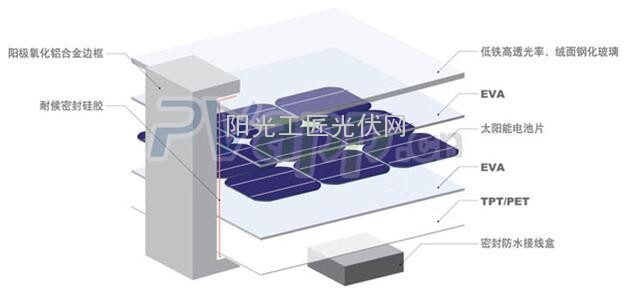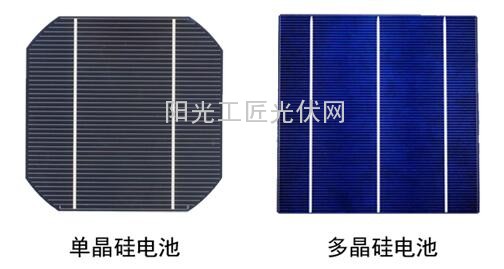Photovoltaic modules, commonly known as solar panels, are the core components of photovoltaic systems. Photovoltaic modules generate a small stream of sunlight that converges to the electricity generated by the photovoltaic system.
Photovoltaic cells are mainly divided into crystalline silicon cells and thin-film batteries, wherein crystalline silicon cells are further divided into polysilicon and monocrystalline silicon, and thin-film batteries generally include silicon-based thin film batteries, copper indium gallium selenide batteries, cadmium telluride batteries, and gallium arsenide batteries. Wait. Since thin-film batteries generally have lower power per unit area than crystalline silicon cells, their cost-effectiveness is relatively low, so they are used less in the market. The efficiency of gallium arsenide batteries is much higher than that of crystalline silicon batteries, but because it is expensive and highly toxic, it is not suitable for civilian use, so this article does not introduce much. This article focuses on the selection of crystalline silicon cell modules in home-installed distributed photovoltaic systems.
The basic components of crystalline silicon photovoltaic modules include: photovoltaic cells, ribbons that connect photovoltaic cells in series and in parallel, ultra-white tempered glass and backplanes sandwiching photovoltaic cells, and tempered glass, serially connected cells. EVA (hot-melt adhesive) with back-sheet bonded together. These materials are heated and laminated to form the body of the photovoltaic module. Finally, in order to strengthen the strength of photovoltaic modules and prevent water and air from entering the laminated structure from the side, aluminum alloy frames are generally installed and filled with silicone (sealed and shock-resistant) between the aluminum alloy frame and the laminated structure.

Among them, the efficiency of polysilicon cells is slightly lower than that of monocrystalline silicon cells (about 10%), but because the production process of polysilicon is slightly lower than that of monocrystalline silicon, the cost of polysilicon cells is generally slightly higher than that of monocrystalline silicon. Therefore, in home systems, the use of polysilicon batteries is more common than monocrystalline silicon. However, due to its higher efficiency and lower production costs, monocrystalline silicon cells are gradually being chosen by more home users who are pursuing performance.
From the appearance, the polysilicon component is generally indigo blue, and the surface has random, different color depth of the piebald, and its shape is a square, a slight angle at the right angle. The monocrystalline silicon is generally dark gray and has a square shape with a large rounded corner.

Whether it is a monocrystalline silicon cell module or a polycrystalline silicon cell module, there are great differences in the final quality and price due to differences in material selection, production processes, and quality control. Because photovoltaic modules are laminated and highly integrated, it is difficult to see differences in the appearance of new components. However, once quality problems occur during use, they are irreversible and have a great impact on efficiency and life. The user should pay special attention and identify when choosing. The battery modules manufactured in accordance with the national standard system generally have a lifetime of more than 25 years. However, inferior components usually have one or more of the aforementioned problems in about 2-3 years, and they are severely scrapped in advance and completely lose their use value.
First of all, the choice of materials, the same is a crystalline silicon component, whether it is monocrystalline silicon or polycrystalline silicon, its materials mainly include solar cells, ribbons, tempered glass panels, EVA, backplanes, silicone, aluminum alloy frame and so on. All of these materials have differences in quality and grade, so the quality of the final product is also very different. Such as the choice of cell, the consistency of the efficiency of the cell, the consistency of color, the amount of copper (or silver) in the ribbon, the transparency and surface passivation treatment of the tempered glass, the adhesive strength and aging resistance of the EVA, back Board waterproof, anti-aging, silicone viscosity, sealing, anti-aging, aluminum alloy model, profile characteristics. These quality differences will result in poor battery module efficiency, rapid decay, premature aging, cracking, and shortened life expectancy. Here again, we will focus on the quality classification of photovoltaic cells: As the quality of photovoltaic cells produced on the production line will not be exactly the same, generally domestic manufacturers will classify photovoltaic modules into A, B, C, O grades.
Class A components generally refer to components that are more efficient and have better electrical performance. According to their different products, they can be divided into A1, A2, A3 and other levels. A1 grades are generally consistent in color and electrical properties and are of the highest quality. A2 generally has a more obvious color difference. Grade A3 is more scratching than A2 but does not affect use. Class B components generally refer to components with certain defects (such as water marks, fingerprints, etc.), good electrical properties, severe color differences, and lower efficiency than A1-class components. According to the color difference and the degree of appearance can be subdivided into B1, B2, B3 and other levels. Class C components generally refer to components that have physical damage to the cell, such as chipping or missing corners, or that have been partially broken but have been reunited after being cut in a uniform form. The O-gap is a battery that has serious problems in the production process and results in no electrical performance. (The manufacturers have slightly different definitions of their grades, and the definition of grades by profiteers is broad and vague)
Followed by the production process and quality control, different manufacturers, in the implementation of the production process, the level of quality control is different. Manufacturers with standardized management and brands have generally higher level of quality control and stricter inspection standards for finished products. Therefore, their product quality is relatively higher and more stable. On the contrary, there are many problems with small manufacturers with poor quality management and brands. Here is a typical example of "tape tape": because the battery is very thin and brittle, inexperienced workshop workers often knock it off in the production process, but because they get a lot more, they will be fined. A lot of irresponsible workers put the broken parts together and taped them on the back. After laminating them into finished products, they basically couldn't see the problem from the front, but because of the incompleteness of the battery, the entire assembly or even the entire assembly was used during use. The efficiency of the string is negatively affected. This kind of problem can be found in manufacturers with better control in the inspection process, but many small-brand manufacturers will let themselves go in order to seek cost savings or poor management.

Therefore, in the selection process of photovoltaic modules, such as the best and most efficient, consider the choice of single crystal components. In the comparison of price/performance ratios, products that cannot be priced at the lowest price will depend on the brand, the reputation of the manufacturer, and the grade of the product.
PV photovoltaic system expert, PVapp, is one of the most professional home photovoltaic system service providers in China. The core team has 10 years of experience in the photovoltaic industry. The main personnel have participated in the national specification of photovoltaic system design, construction, and acceptance, and they have from 10kW to 20MW each. The design and construction experience of grade PV power plants and building integration projects. In specific projects, A1 components of domestic first-tier brand manufacturers are selected, and more and more efficient single-crystal silicon components are used to create high-efficiency, long-life, and stable-return home-distributed photovoltaic power plants for customers.
The Infrared Heater is a new kind, good looking and eco-friendly product. The heating method is by far infrared wave, which is efficient and very good to human health.
The heater is very safe, even to the children. The main body panel has no-electricity, so there will be no electric leak. Also the surface of the board has anti-heat burn process. The children touches the surface, he or she will feel hot but they will not get burned.
Dexiang company is the leader company of industry, founded in 2008, Dexiang is the frontieer and the standard maker of industry.
We welcome friends all over the world to be our dealer and make double win future !
Heating Paint,Heating Paint With Thermostat,Electric Heating Paint,Heat Reflecting Roof Paint
Shandong Dexiang Electrical Technology Co.,Ltd , https://www.infraredroomheater.com
